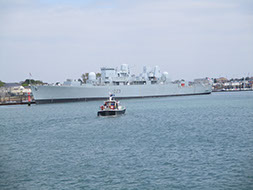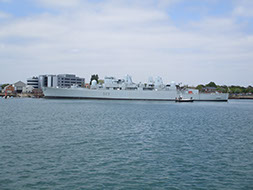Royal Navy destroyer H.M.S. Bristol


Type 82 Destroyer H.M.S. Bristol was laid down on November 15, 1967, by Swan Hunter, Tyne and Wear. H.M.S. Bristol was launched on June 30, 1969, and after completing builders’ trials, she was commissioned on March 31, 1973. H.M.S. Bristol is 507 feet long with a beam of 55 feet. Propulsion comes from a C.O.S.A.G., combined steam and gas turbines power plant, 30,000 shaft horsepower using the steam turbines and 44,600 shaft horsepower with the gas turbines. H.M.S. Bristol holds the distinction of being the last Royal Navy ship to employ steam turbines.
Air Defense Escort
H.M.S. Bristol was originally designed for the purpose of being the primary Air Defense Escort for the proposed C.V.A. 01 aircraft carrier which as it turns out was canceled during the 1966 Strategic Defense Review. However, after the massive expense of design and development, the Royal Navy proceeded to build H.M.S. Bristol the only one of the four projected ships in her class in order to recoup some of the cost of the canceled project.
H.M.S. Bristol’s armaments
H.M.S. Bristol would be built to deploy the new Sea Dart Surface to Air Missile system with the fleet as soon as possible and she would also serve as a test bed for several new weapons systems that were soon to join the fleet in order to train Royal Navy personnel in their operation. The Sea Dart would be H.M.S. Bristol’s primary air defense weapon employing a twin armed launcher aft served by a 40 round magazine. She was also armed with an Mk 8 single 4.5 inch automated main gun that possessed a limited anti-aircraft capability and anti-ship and shore bombardment ability and for additional protection two single 20mm cannons. For Anti-Submarine Warfare H.M.S. Bristol was well armed with a primary A.S.W. system based on the Ikara missile system equipped with a 32 round magazine. The Ikara was a rocket that can deliver a small homing torpedo and this was supplemented with a three barreled Limbo Anti-Submarine Mortar System. H.M.S. Bristol’s armaments are operated by a highly advanced control system. The Ships’ Inertial Navigation System (S.I.N.S.) is connected to the Action Data Automation Weapons System Mk2 which can control and activate the entire weapons suite automatically. She was the first warship in the Royal Navy to employ such a system.
Into service
Shortly after being commissioned in 1974, H.M.S. Bristol suffered a boiler fire that disabled the ships steam propulsion plant. Despite this damage, she was able to remain operational using only her gas turbine power plant for another two years until the steam power plant was repaired in 1976. In September 1981, H.M.S. Bristol was employed as the flagship of the Royal Navy contingent during Exercise Ocean Safari 1981. Exercise Ocean Safari 1981 was an N.A.T.O. Naval exercise intended to demonstrate N.A.T.O.’s ability to protect shipping lanes in the event of war with the Soviet Union. It is somewhat ironic that H.M.S. Bristol was participating in war games at this time considering the fact that in only a matter of months, she would be in action in a real war.
The Falklands War
Beginning April 3, 1982, H.M.S. Bristol, along with the rest of the Royal Navy’s assets and personnel were placed on alert and prepared for operations in the South Atlantic as a result of the Argentinian invasion of the Falkland Islands. Although she did not sail with the carrier task force, preparations were made for the ship to sail to the South Atlantic as the flagship of what became known as the Bristol Group of reinforcements to replenish and replace warships of the carrier task force that were damaged during the war. H.M.S. Bristol did not enter the war zone until May 23, 1982, where she served in defense of the carrier task force. However, on May 22, 1982 while serving as the flagship of the Bristol Group, H.M.S. Bristol and H.M.S. Cardiff detected the presence of a Boeing 707 of the Fuerza Aereo Argentina. Fuerza Aereo Argentina possessed two Boeing 707’s in its Gruppo 1, operating out of El Palomar air base near Buenos Aires for use as transports however at this time they were being employed in the Maritime Reconnaissance role. Upon detecting the Boeing 707 and determining the nature of its mission, H.M.S. Bristol and H.M.S. Cardiff engaged the aircraft with their Sea Dart Surface to Air Missiles at extreme range. The Boeing 707 was forced to turn away from this threat and dive out of range to safety. When the Bristol Group joined the carrier task force the next day, she remained to augment the defenses of the task force and on May 25, 1982 when H.M.S. Coventry was sunk, H.M.S. Bristol assumed her station in the anti-aircraft screen. At wars end, the bulk of the carrier task force, led by H.M.S .Hermes returned to England with the role of flagship of the remaining task force being assumed by H.M.S. Bristol who was in turn relieved on September 17, 1982 by H.M.S. Illustrious.
Return to England and peacetime
H.M.S. Bristol finally returned to England in 1983 and immediately went into dockyard hands for a refit. In 1984 during another refit, H.M.S. Bristol suffered another boiler explosion which required major repair work to be carried out. In 1987, H.M.S. Bristol was nearing the end of her active service life and became a training ship in Dartmouth until 1991 when she was paid off.
H.M.S. Bristol today
Later after additional refitting, the removal of all armaments and radar and additional classroom and accommodation facilities installed, in 1993 she was still in commission and assumed the role of a static accommodation and training ship at Portsmouth Naval Base. She is used by the Royal Navy, the Royal Marine Reserves for training and she is also used by the Sea Cadets and Sea Scouts to give them their experience of life aboard ship. Currently H.M.S. Bristol is permanently moored at Whale Island at Portsmouth Naval Base in southern England.
Authors note
Normally I try to stick to subjects that are readily available for the public to take tours or locations where the average person can visit and appreciate. However, H.M.S. Bristol is NOT open to the general public to visit, it is after all still a commissioned warship of the Royal Navy. While visiting the Portsmouth Historic Dockyard in May 2017, I took the opportunity to take the Harbor Tour at which time I noticed an interesting looking warship. I took a couple of pictures and noticed its Pennant Number and following my return home I learned of the ships’ identity and history. At that point I decided to include it on my website.
Ken Keller
